Investigation of the Mechanical Behaviors and Damage Mechanism of C/C Composites Impacted by High-Velocity Jets
Abstract
:1. Introduction
2. Materials and Methods
2.1. Three-Dimensional Orthogonal C/C Composites
2.2. Test Platform
3. Experimental Results
3.1. Single-Jet Impact Tests
3.2. Multi-Jet Impact Tests
3.3. Residual Mechanical Properties after Jet Impact
4. Discussion
4.1. Damage Mechanism of Jet Impact
4.2. Effects of Jet Velocity and Diameter
4.3. Z-Directional Fiber Bundles Damage Resistance
4.4. Mechanism of Decreased Residual Mechanical Properties
5. Conclusions
- (1)
- Under the action of single-jet impingement, the damage types of C/C composite materials included fiber bundle fracturing, delamination, and debonding. The damage threshold velocity for a single-jet impingement was 323 m/s when the nozzle diameter was 0.8 mm and 300 m/s when the nozzle diameter was 1.2 mm. The extent of damage was positively correlated with the jet velocity and diameter.
- (2)
- Z-directional fiber bundles in three-dimensional orthogonal C/C composites exhibit a significant control effect on jet impact damage. Through multi-jet impact tests, the limitation of z-directional fiber bundles on in-plane damage propagation becomes more pronounced. The results showed that fiber bundles oriented perpendicular to the jet impact direction have superior impact resistance, highlighting their effectiveness in limiting in-plane damage expansion.
- (3)
- The experimental results indicated that a larger jet impact damage corresponded to lower residual mechanical properties of the material. At higher impact velocities, the manifestation of the stress wave action initiates a shift in the damage mode of the specimen, whereby reflected tensile waves induce damage to the rear of the specimen. The three-point bending tests resulted in an increase in stress concentration, ultimately leading to a marked deterioration of the residual mechanical properties.
Author Contributions
Funding
Institutional Review Board Statement
Informed Consent Statement
Data Availability Statement
Conflicts of Interest
References
- Li, H.; Li, A.; Bai, R.; Li, K. Numerical simulation of chemical vapor infiltration of propylene into C/C composites with reduced multi-step kinetic models. Carbon 2005, 43, 2937–2950. [Google Scholar] [CrossRef]
- Li, W.; Jian, Y.; Xingui, Z. In Situ tensile damage characterization of C/C composites through X-ray computed tomography and digital volume correlation. Ceram. Int. 2023, 49, 10471–10480. [Google Scholar] [CrossRef]
- Yuan, Q.; Li, Y.; Li, H.; Li, S.; Guo, L. Strain rate-dependent compressive properties of C/C composites. Mater. Sci. Eng. A 2008, 485, 632–637. [Google Scholar] [CrossRef]
- Wang, J.; Tao, Z.; Yang, R.; Gao, Z.; Shan, D.; Wang, W. A review of aircraft fire accident investigation techniques: Research, process, and cases. Eng. Fail. Anal. 2023, 153, 107558. [Google Scholar] [CrossRef]
- Longbiao, L. Failure analysis of long-fiber-reinforced ceramic-matrix composites subjected to in-phase thermomechanical and isothermal cyclic loading. Eng. Fail. Anal. 2019, 104, 856–872. [Google Scholar]
- Shi, Y.; Zha, B.; Sun, Z.; Shen, Q.; Miao, W.; Gao, Y. Air plasma ablation/erosion test for 4D C/C composites used in the throat of solid rocket motor. Ceram. Int. 2022, 48, 15582–15593. [Google Scholar] [CrossRef]
- Shen, X.; Liu, L.; Li, W.; Li, K. Ablation behaviour of C/C–ZrC composites in a solid rocket motor environment. Ceram. Int. 2015, 41, 11793–11803. [Google Scholar] [CrossRef]
- Awasthi, S.; Wood, J.L. C/C Composite Materials for Aircraft Brakes. In Proceedings of the 12th Annual Conference on Composites and Advanced Ceramic Materials, Part 1 of 2: Ceramic Engineering and Science Proceedings; The American Ceramic Society, Inc.: Westerville, OH, USA, 2008; Volume 9, pp. 553–559. [Google Scholar]
- Manocha, L.M. High performance carbon-carbon composites. Sadhana 2003, 28, 349–358. [Google Scholar] [CrossRef]
- Gao, Y.; Zha, B.-L.; Wang, J.-J.; Sun, Z.-S.; Zhang, Z.-F.; Shi, Y.-A. Ablation mechanism of C/C–SiC and C/C–SiC–ZrC composites in hypersonic oxygen-enriched environment. Ceram. Int. 2022, 48, 22985–22993. [Google Scholar] [CrossRef]
- Peng, L.N.; He, G.Q.; Li, J.; Wang, L.; Qin, F. Effect of combustion gas mass flow rate on carbon/carbon composite nozzle ablation in a solid rocket motor. Carbon 2012, 50, 1554–1562. [Google Scholar] [CrossRef]
- Williams, S.D.; Curry, D.M.; Chao, D.C.; Pham, V.T. Ablation Analysis of the Shuttle Orbiter Oxidation-Protected Reinforced Carbon/Carbon. J. Thermophys. Heat Transf. 1995, 9, 478–485. [Google Scholar] [CrossRef]
- Glass, D.E.; Camarda, C.J. Preliminary thermal/structural analysis of a carbon-carbon/refractory-metal heat-pipe-cooled wing leading edge. In Thermal Structures and Materials for High-Speed Flight; AIAA: Reston, VA, USA, 1992; pp. 301–322. [Google Scholar]
- Golecki, I.; Xue, L.; Leung, R.; Walker, T.; Horik, J.V. Properties of high thermal conductivity carbon-carbon composites for thermal management applications. In Proceedings of the High-Temperature Electronic Materials, Devices and Sensors Conference, San Diego, CA, USA, 22–27 February 1998; pp. 190–195. [Google Scholar]
- Walker, J.D. From Columbia to Discovery: Understanding the impact threat to the space shuttle. Int. J. Impact Eng. 2009, 36, 303–317. [Google Scholar] [CrossRef]
- Kim, D.H.; Kim, S.W. Evaluation of bird strike-induced damages of helicopter composite fuel tank assembly based on fluid-structure interaction analysis. Compos. Struct. 2018, 210, 676–686. [Google Scholar] [CrossRef]
- Long, S.; Mu, X.; Liu, Y.; Wang, H.; Yao, X. Failure modeling of composite wing leading edge under bird strike. Compos. Struct. 2021, 255, 113005. [Google Scholar] [CrossRef]
- Gang, L.; Ziming, X.; Haitao, S.; Wei, C.; Zhang, H. Experimental study on the impact load of internally supported gelatin bird projectiles. Eng. Fail. Anal. 2021, 124, 105336. [Google Scholar]
- Zhang, F.; Luo, G.; Zhang, H.; Cong, P.; Liu, L.; Chen, W. Experimental and numerical analysis study on the low and medium speed bird strike. Eng. Fail. Anal. 2024, 156, 107766. [Google Scholar] [CrossRef]
- Field, J.E. ELSI conference: Invited lecture: Liquid impact: Theory, experiment, applications. Wear 1999, 233–235, 1–12. [Google Scholar] [CrossRef]
- Gohardani, O. Impact of erosion testing aspects on current and future flight conditions. Prog. Aerosp. Sci. 2011, 47, 280–303. [Google Scholar] [CrossRef]
- Hou, N.; Zhao, R.; Li, J.; Wang, X.; Li, X.; Cui, H.; Li, Y. Impact damage of composite laminates with high-speed waterjet. Int. J. Impact Eng. 2022, 167, 104276. [Google Scholar] [CrossRef]
- Zhao, R.; Hou, N.; Wang, X.; Yue, Y.; Wang, B.; Li, Y.; Zhang, C.; More, S. Mechanical response and damage mechanism of C/SiC composites impacted by high-velocity water jet. J. Eur. Ceram. Soc. 2023, 43, 3158–3171. [Google Scholar] [CrossRef]
- Fyall, A.A.; King, R.B.; Strain, R.N.C. Rain Erosion Aspects of Aircraft and Guided Missiles. Aeronaut. J. 2016, 66, 447–453. [Google Scholar] [CrossRef]
- Ahmad, M. An Overview of Droplet Impact Erosion, Related Theory and Protection Measures in Steam Turbines. Cavitation—Sel. Issues 2018, 91, 91–108. [Google Scholar]
- Cook, S.S. Erosion by water-hammer, Proceedings of the Royal Society of London. Proceedings of The Royal Society A: Mathematical. Phys. Eng. Sci. 1928, 119, 481–488. [Google Scholar]
- Matthewson, M.J.; Gorham, D.A. An investigation of the liquid impact properties of a GFRP radome material. J. Mater. Sci. 1981, 16, 1616–1626. [Google Scholar] [CrossRef]
- Kirols, H.S.; Kevorkov, D.; Uihlein, A.; Medraj, M. The effect of initial surface roughness on water droplet erosion behaviour. Wear 2015, 342–343, 198–209. [Google Scholar] [CrossRef]
- Hand, R.J.; Field, J.E.; Townsend, D. The use of liquid jets to simulate angled drop impact. J. Appl. Phys. 1991, 70, 7111–7118. [Google Scholar] [CrossRef]
- Wang, X.; Xu, J.; Cui, H.; Hou, N.; Li, Y. On the damage behavior of poly(methyl methacrylate) impacted by high-velocity water jet. J. Non-Cryst. Solids 2022, 595, 121838. [Google Scholar] [CrossRef]
- Coto, B.; Hallander, P.; Mendizabal, L.; Pagano, F.; Kling, H.; Ortiz, R.; Barriga, J.; Selegard, L. Particle and rain erosion mechanisms on Ti/TiN multilayer PVD coatings for carbon fibre reinforced polymer substrates protection. Wear 2021, 466–467, 203575. [Google Scholar] [CrossRef]
- Hatta, H.; Aly-Hassan, M.S.; Hatsukade, Y.; Wakayama, S.; Kasai, N. Damage detection of C/C composites using ESPI and SQUID techniques. Compos. Sci. Technol. 2005, 65, 1098–1106. [Google Scholar] [CrossRef]
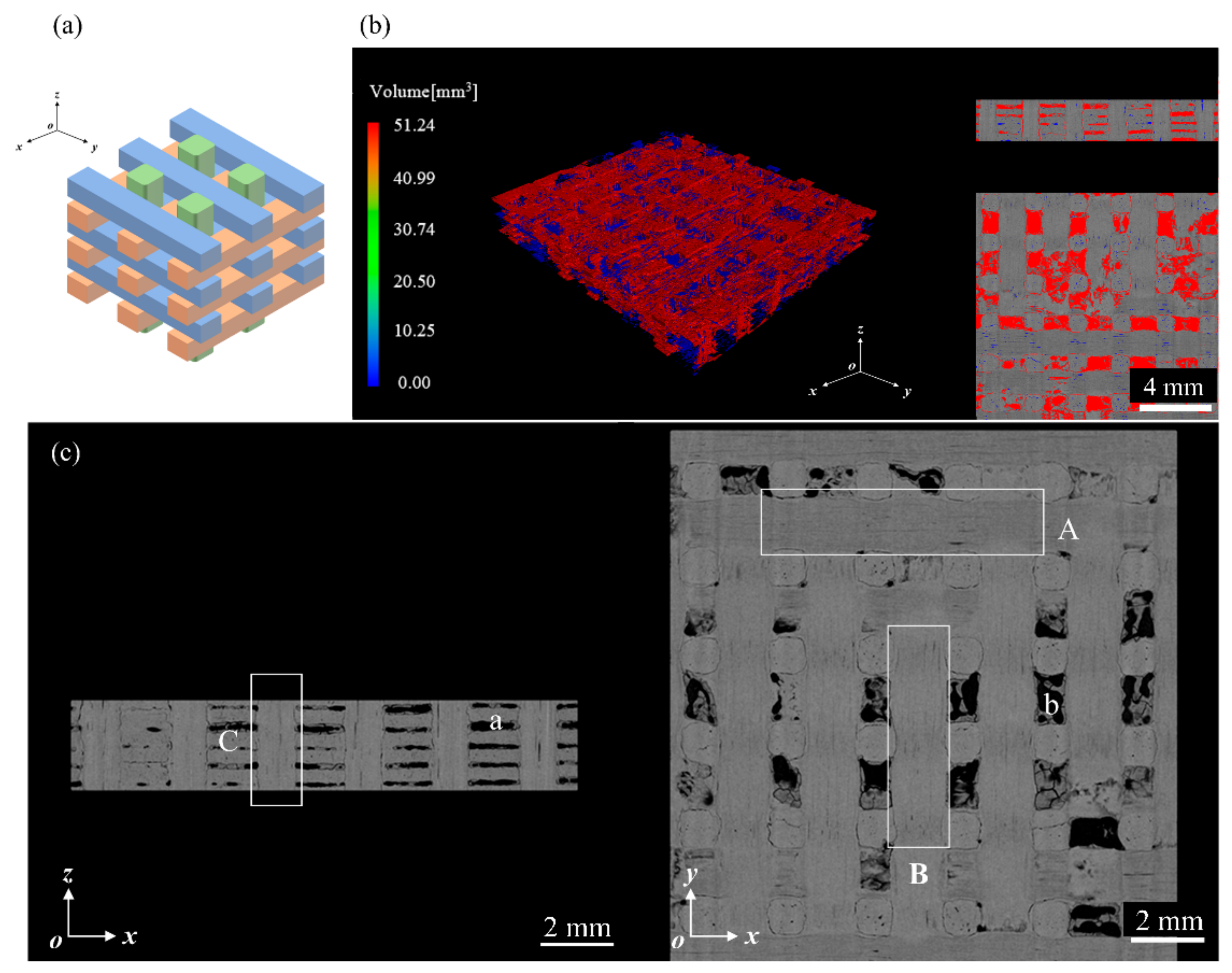

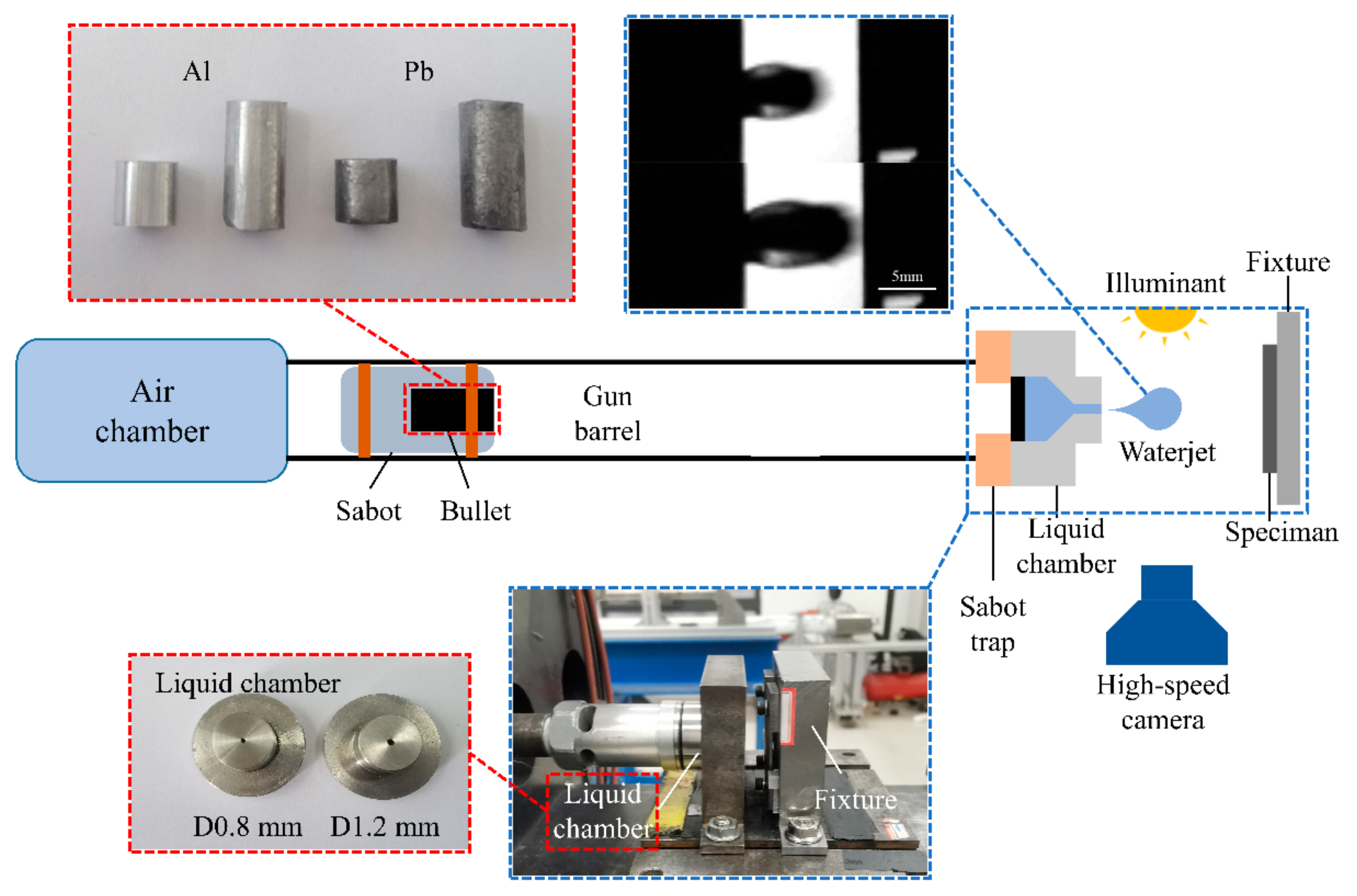


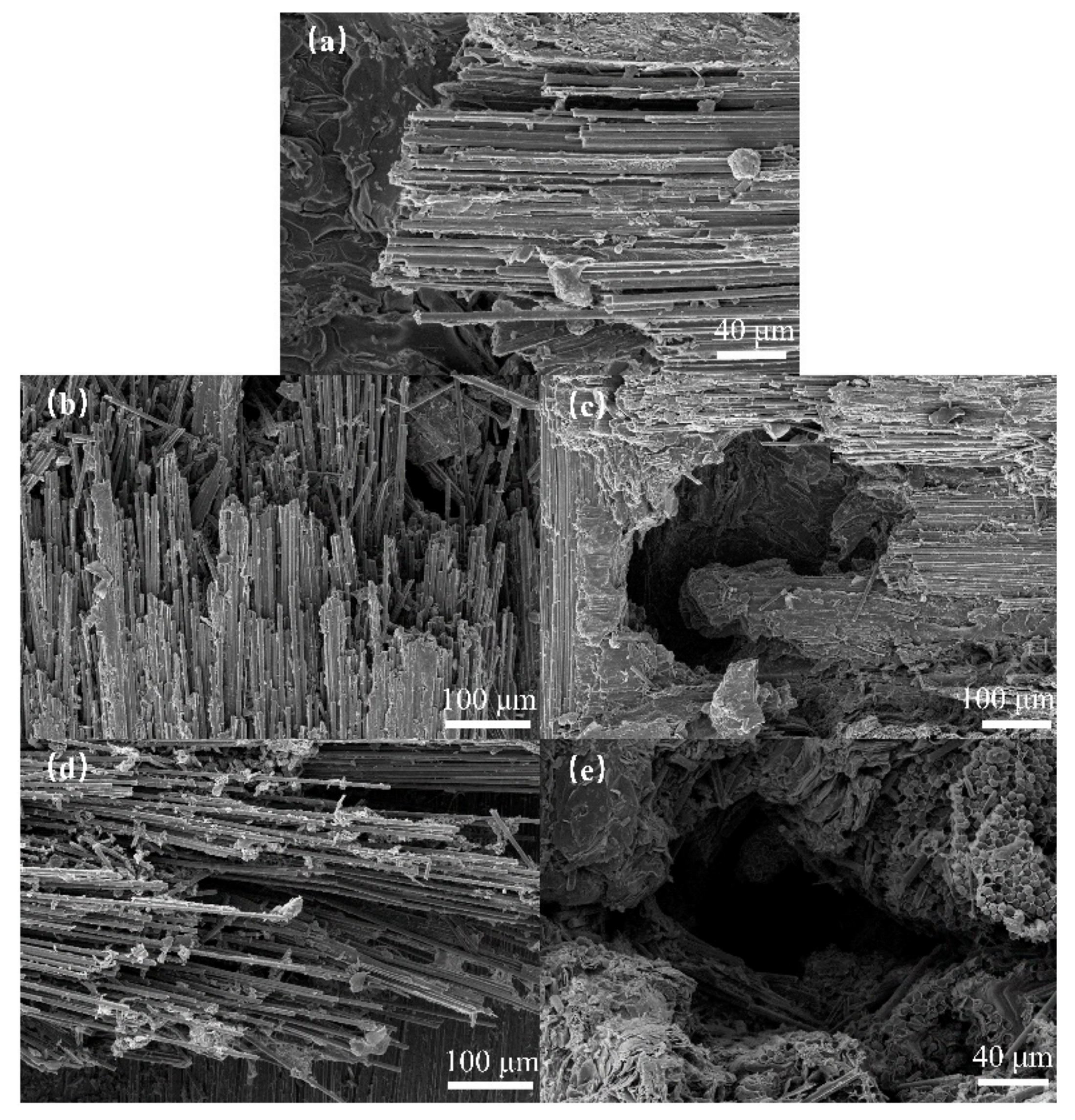

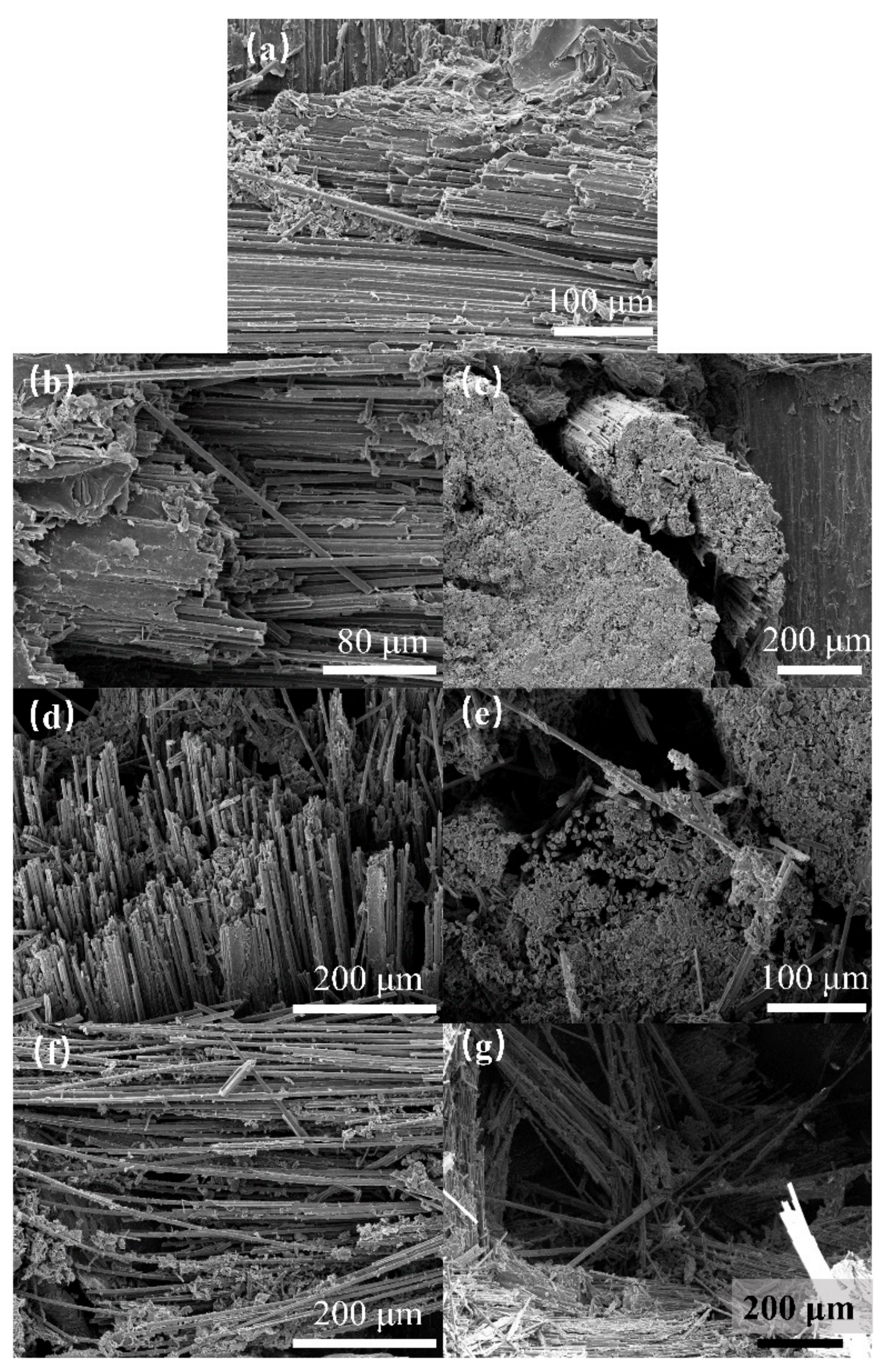
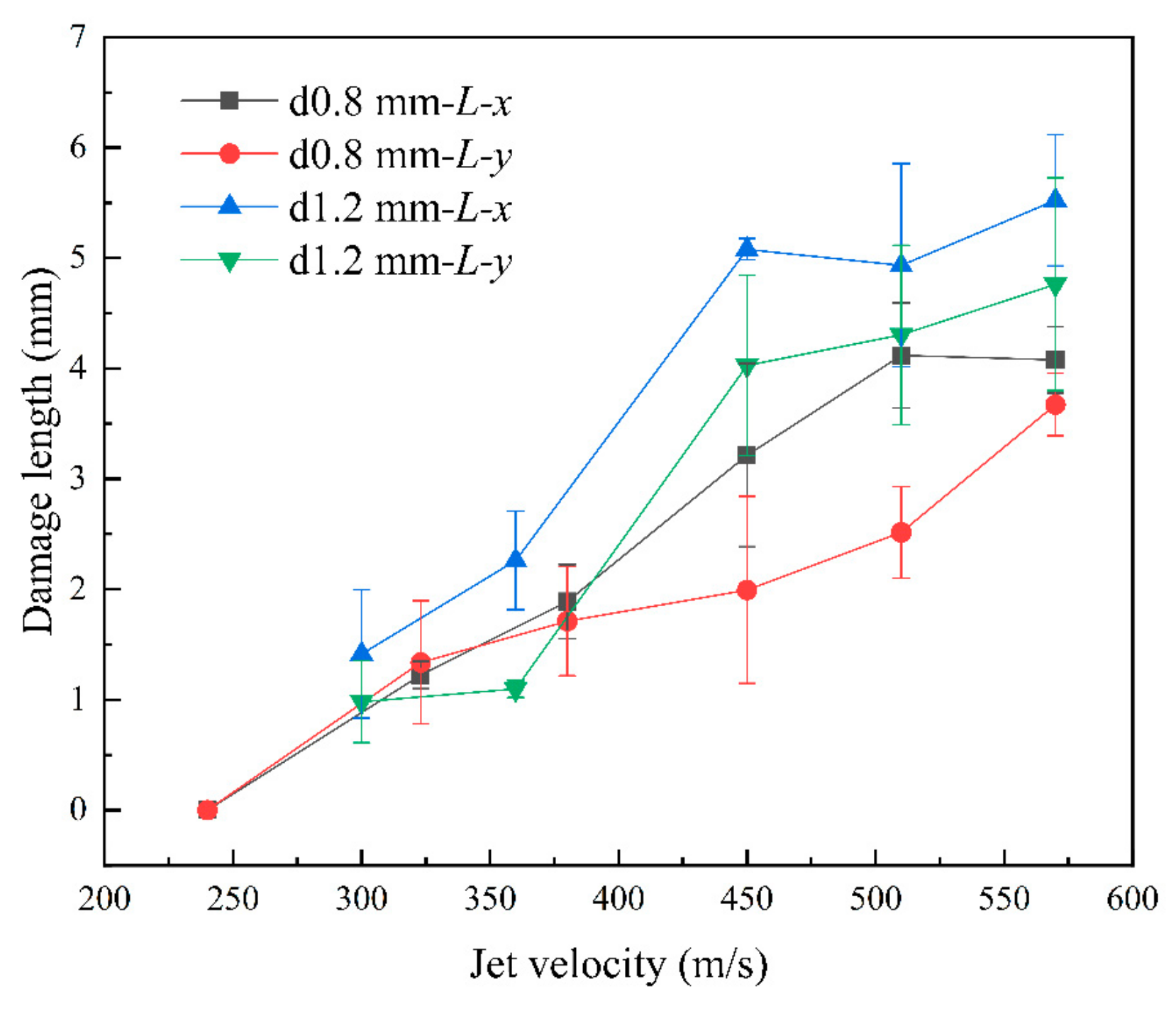
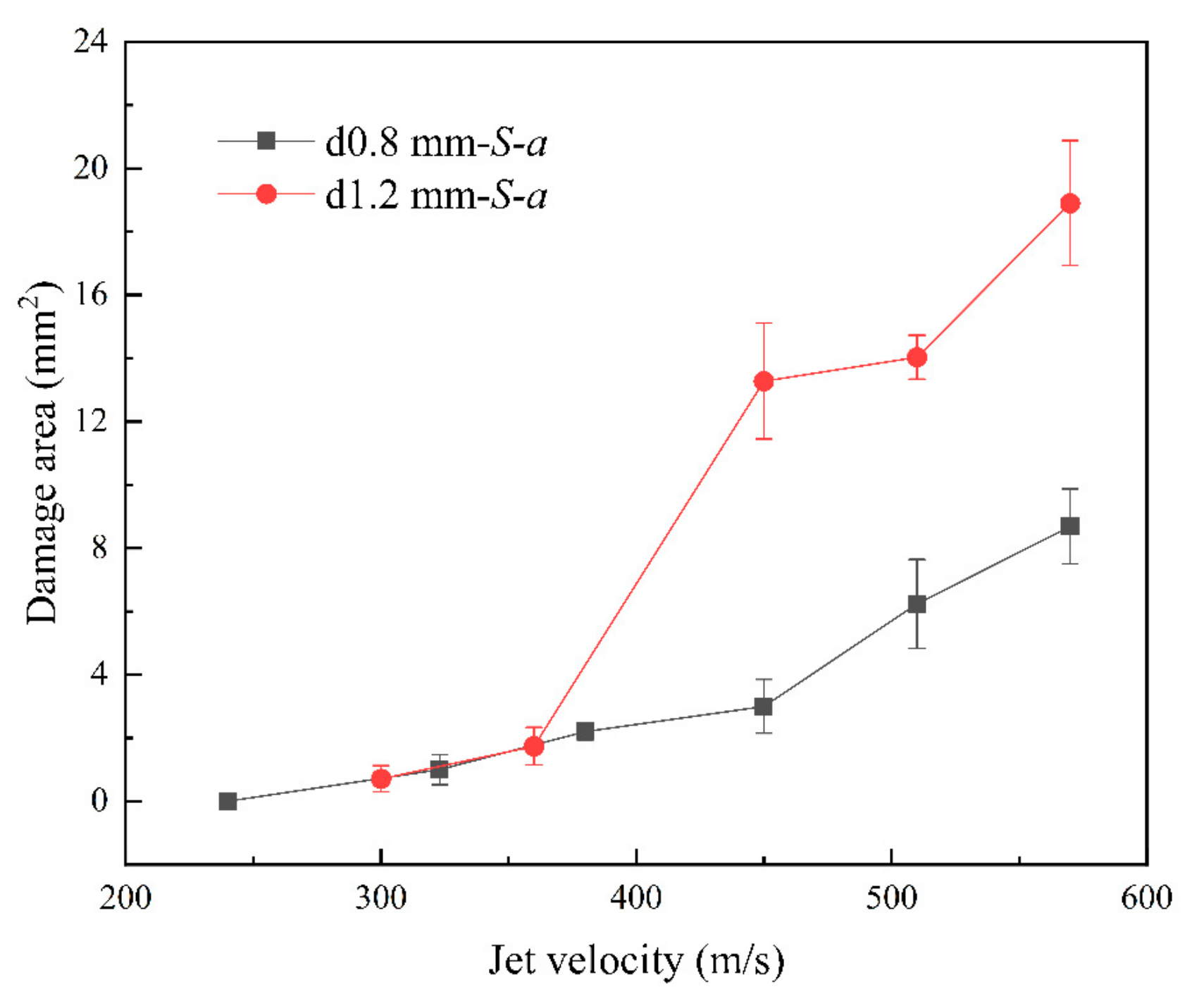


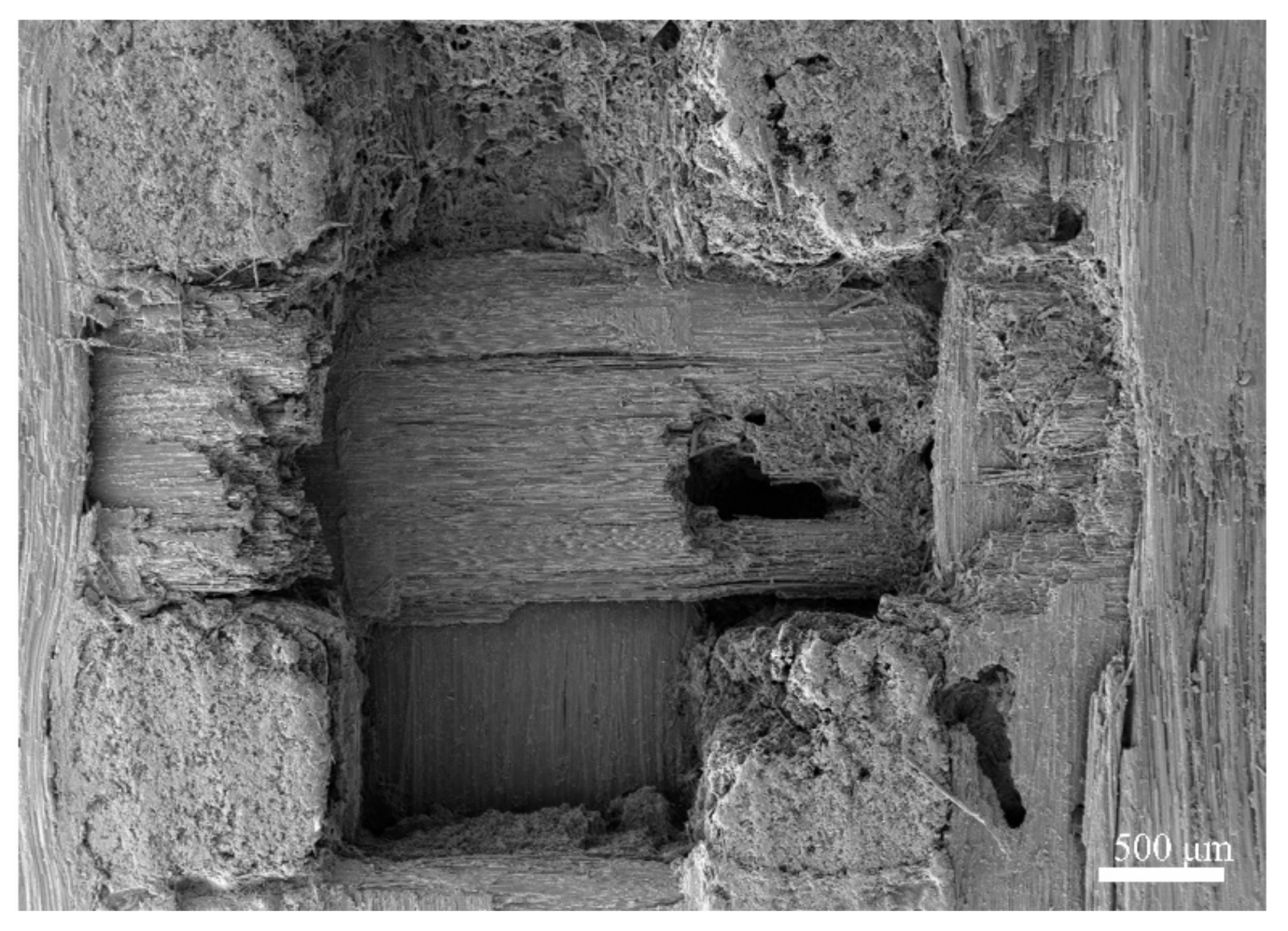
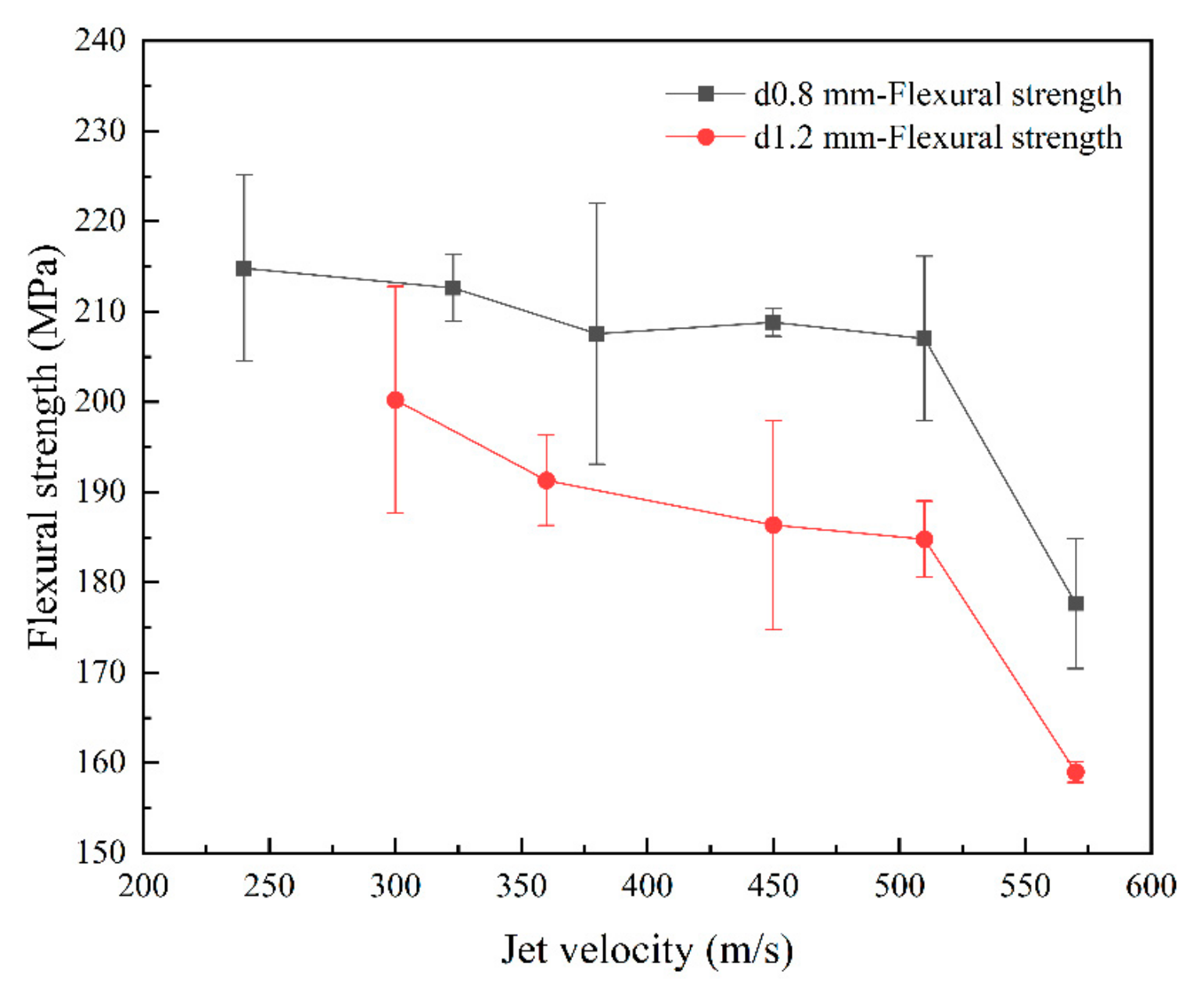
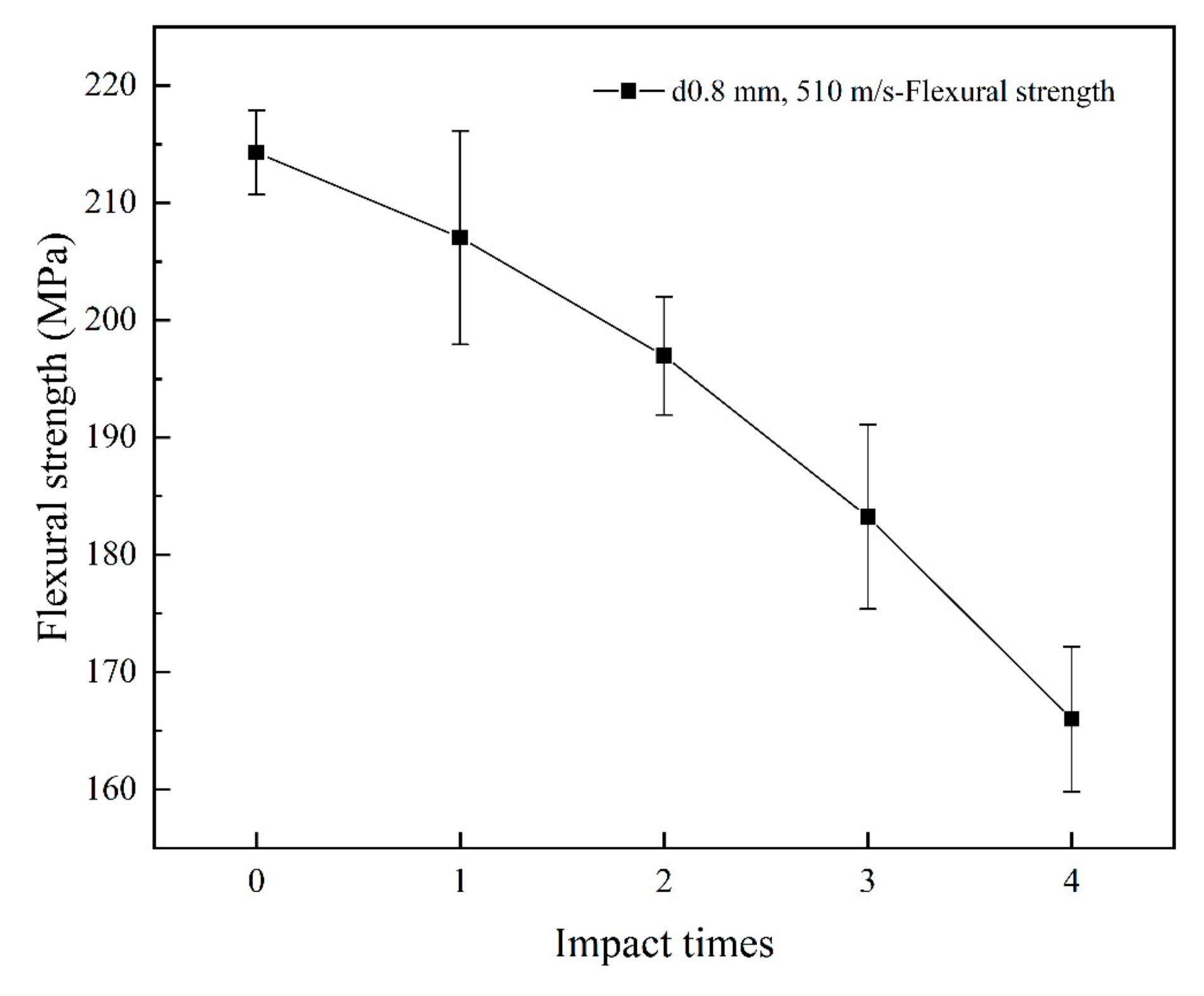

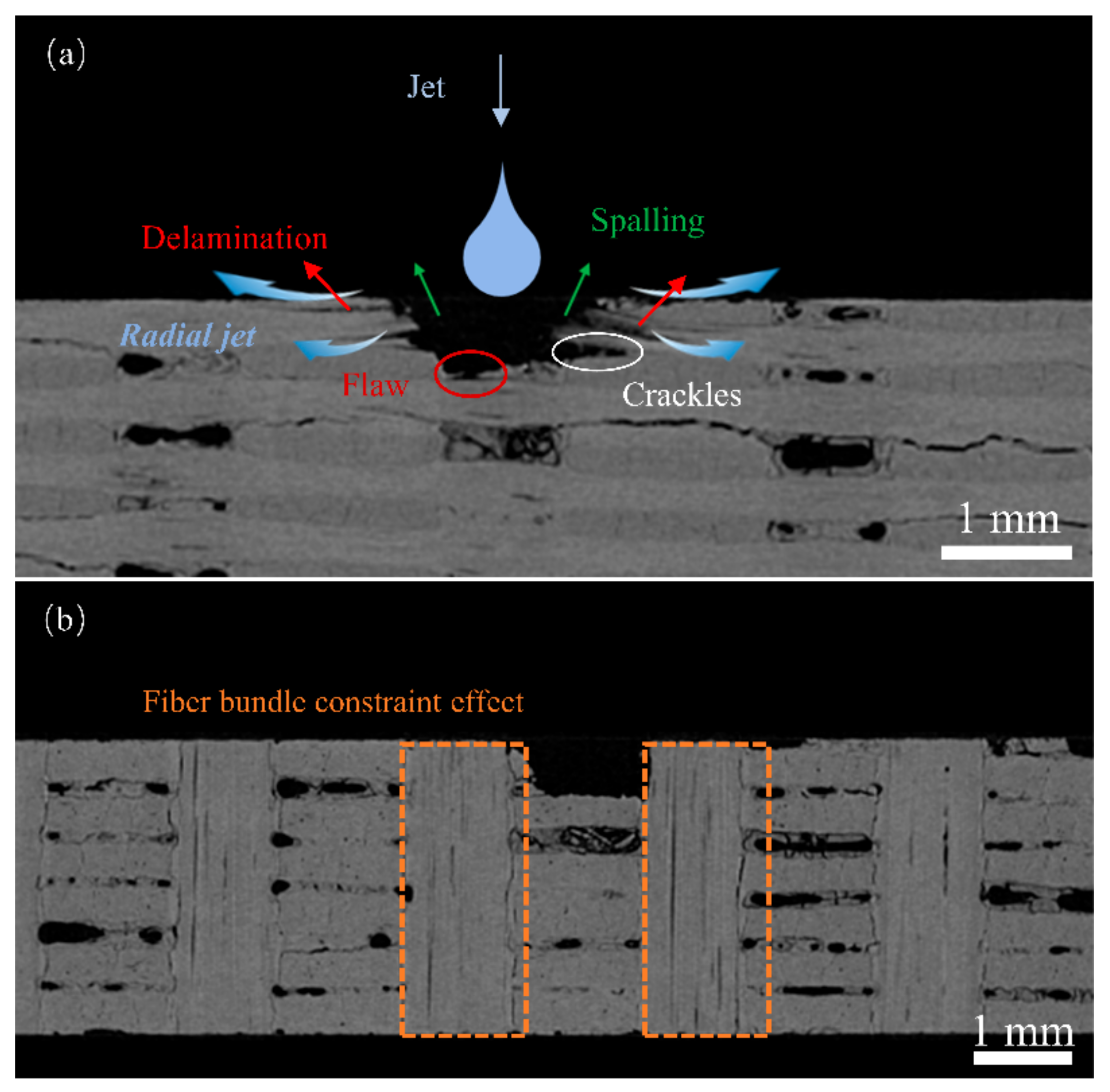





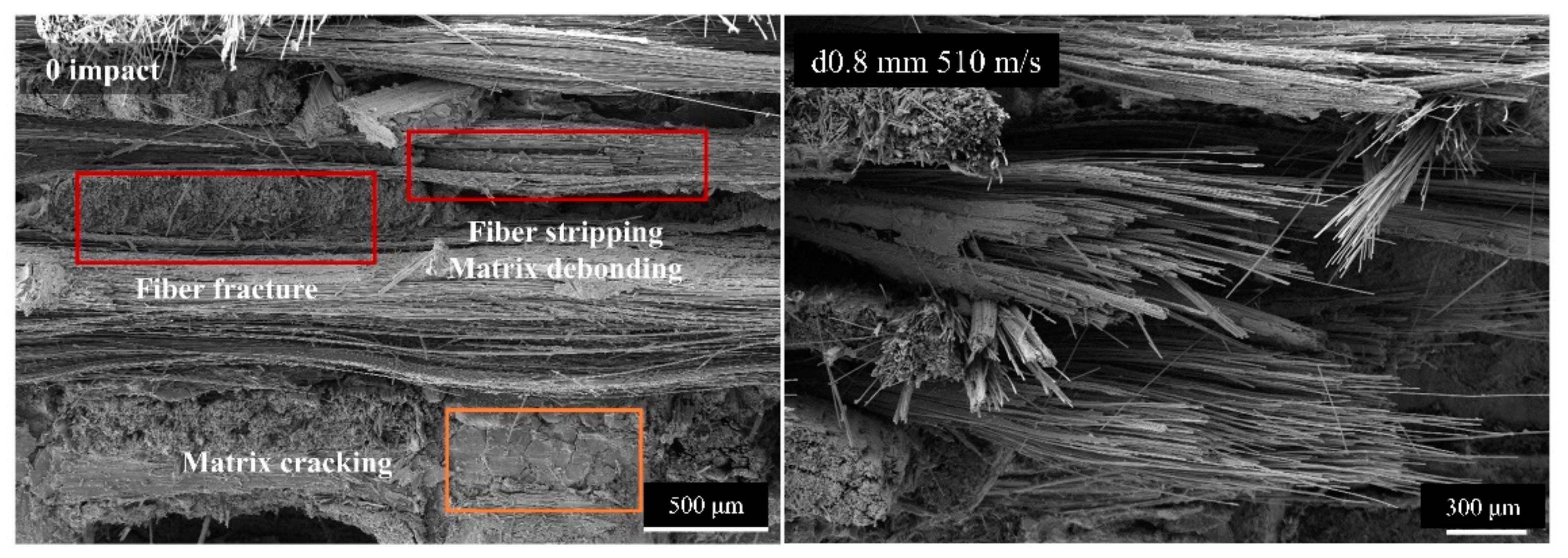

| Test Parameters | |
|---|---|
| Nozzle orifice diameter | 0.8 mm, 1.2 mm |
| Jet diameter | 4.7 mm, 5.8 mm |
| Chamber pressure | 0.2–0.7 MPa |
| Jet velocity | 240–570 m/s |
| Target Parameters | |
| Dimension | 96 mm × 16 mm |
| Thickness | 3 mm |
| Nozzle Orifice Diamter/mm | Jet Velocity/ms−1 | L-x/mm | L-y/mm | S-a/mm2 |
|---|---|---|---|---|
| 0.8 | 240 | 0.000 | 0.000 | 0.000 |
| 0.8 | 323 | 1.224 | 1.338 | 1.003 |
| 0.8 | 380 | 1.890 | 1.712 | 2.204 |
| 0.8 | 450 | 3.214 | 1.993 | 2.998 |
| 0.8 | 510 | 4.117 | 2.516 | 6.237 |
| 0.8 | 570 | 4.077 | 3.673 | 8.684 |
| 1.2 | 300 | 1.415 | 0.981 | 0.710 |
| 1.2 | 360 | 2.262 | 1.097 | 1.737 |
| 1.2 | 450 | 5.078 | 4.027 | 13.276 |
| 1.2 | 510 | 4.933 | 4.304 | 14.032 |
| 1.2 | 570 | 5.522 | 4.762 | 18.897 |
| Impact Times | L-x/mm | L-y/mm | S-a/mm2 | Depth/mm |
|---|---|---|---|---|
| 1 | 4.117 | 2.516 | 6.237 | 0.712 |
| 2 | 4.123 | 2.754 | 7.896 | 0.729 |
| 3 | 4.619 | 4.220 | 12.049 | 1.01 |
| 4 | 4.827 | 4.580 | 14.106 | 1.659 |
Disclaimer/Publisher’s Note: The statements, opinions and data contained in all publications are solely those of the individual author(s) and contributor(s) and not of MDPI and/or the editor(s). MDPI and/or the editor(s) disclaim responsibility for any injury to people or property resulting from any ideas, methods, instructions or products referred to in the content. |
© 2024 by the authors. Licensee MDPI, Basel, Switzerland. This article is an open access article distributed under the terms and conditions of the Creative Commons Attribution (CC BY) license (https://creativecommons.org/licenses/by/4.0/).
Share and Cite
Yue, Y.; Wang, B.; Yan, K.; Zhao, R.; Zhang, C.; Li, Y. Investigation of the Mechanical Behaviors and Damage Mechanism of C/C Composites Impacted by High-Velocity Jets. Materials 2024, 17, 963. https://doi.org/10.3390/ma17040963
Yue Y, Wang B, Yan K, Zhao R, Zhang C, Li Y. Investigation of the Mechanical Behaviors and Damage Mechanism of C/C Composites Impacted by High-Velocity Jets. Materials. 2024; 17(4):963. https://doi.org/10.3390/ma17040963
Chicago/Turabian StyleYue, Yifan, Bo Wang, Kefei Yan, Renxi Zhao, Chengyu Zhang, and Yulong Li. 2024. "Investigation of the Mechanical Behaviors and Damage Mechanism of C/C Composites Impacted by High-Velocity Jets" Materials 17, no. 4: 963. https://doi.org/10.3390/ma17040963




